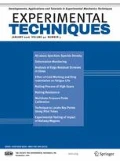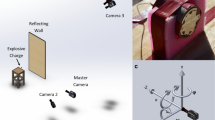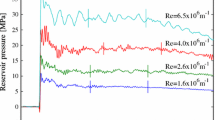Abstract
Experimental studies of multiple shock wave interaction to study transition from regular to irregular reflection rely on the processing of a large amount of schlieren photographs. Here we present an automated algorithm to track individual shock fronts and triple points. First, correction to any optical distortions is applied to the photographs. Next, noise removal and edge detection algorithms are implemented to extract the pixel locations of the shocks. The edge detection algorithm takes advantage of the light intensity feature of the shock waves to distinguish shock fronts from background noise. This algorithm is also capable of separating entangled shock fronts through pattern recognition, which utilizes a discretization method to reduce complex shock geometries to localized linear patterns. Collectively, the algorithms can track shock wave characteristics to sub-pixel precision. This algorithm has been deployed for post processing of shock wave experiments to extract shock wave characteristics including positions and propagation velocities of shock fronts, vertical and horizontal velocities of Mach stems, and triple point trajectories during shock-shock interactions. Results show that the algorithm can process large volumes of data with minimal manual operations, making image processing more precise, efficient and productive while allowing for tracking of Mach stems and triple points.













Similar content being viewed by others
References
Cui S, Wang Y, Qian X, Deng Z (2013) Image processing techniques in shockwave detection and modeling. J Signal Inf Process 04(03):109–113
Mellor W, Lakhani E, Valenzuela J, Lawlor B, Zanteson J, Eliasson V (2020) Design of a multiple exploding wire setup to study shock wave dynamics. Exp Tech 44:241–248
Settles GS (2012) Schlieren and Shadowgraph Techniques. Visualizing Phenomena in Transparent Media. Springer Science & Business Media
Serra J (1986) Introduction to mathematical morphology. Comput Vis Graph Image Process 35 (3):283–305. https://doi.org/10.1016/0734-189X(86)90002-2
Estruch D, Lawson NJ, MacManus DG, Garry KP, Stollery JL (2008) Measurement of shock wave unsteadiness using a high-speed schlieren system and digital image processing. Rev Sci Instrum 79(12):126108–4
Dela Cueva JC, Zheng L, Lawlor B, Nguyen K, Westra A, Nunez J, Zanteson J, McGuire C, Chavez Morales R, Katko BJ, Liu H, Eliasson V (2020) Blast wave interaction with structures: an application of exploding wire experiments. Multiscale and Multidisciplinary Modeling, Experiments and Design. https://doi.org/10.1007/s41939-020-00076-0
Acknowledgements
This study was partially supported by the US Air Force Research Laboratory under grant No. FA8651-17-1-004 and the National Science Foundation under grant number CBET-1803592.
Author information
Authors and Affiliations
Corresponding author
Ethics declarations
Conflict of interests
On behalf of all authors, the corresponding author states that there is no conflict of interest.
Additional information
Publisher’s Note
Springer Nature remains neutral with regard to jurisdictional claims in published maps and institutional affiliations.
This study was partially supported by the US Air Force Research Laboratory under grant No. FA8651-17-1-004 and the National Science Foundation under grant number CBET-1803592.
Rights and permissions
About this article
Cite this article
Zheng, L., Lawlor, B., Katko, B. et al. Image Processing and Edge Detection Techniques to Quantify Shock Wave Dynamics Experiments. Exp Tech 45, 483–495 (2021). https://doi.org/10.1007/s40799-020-00415-3
Received:
Accepted:
Published:
Issue Date:
DOI: https://doi.org/10.1007/s40799-020-00415-3




